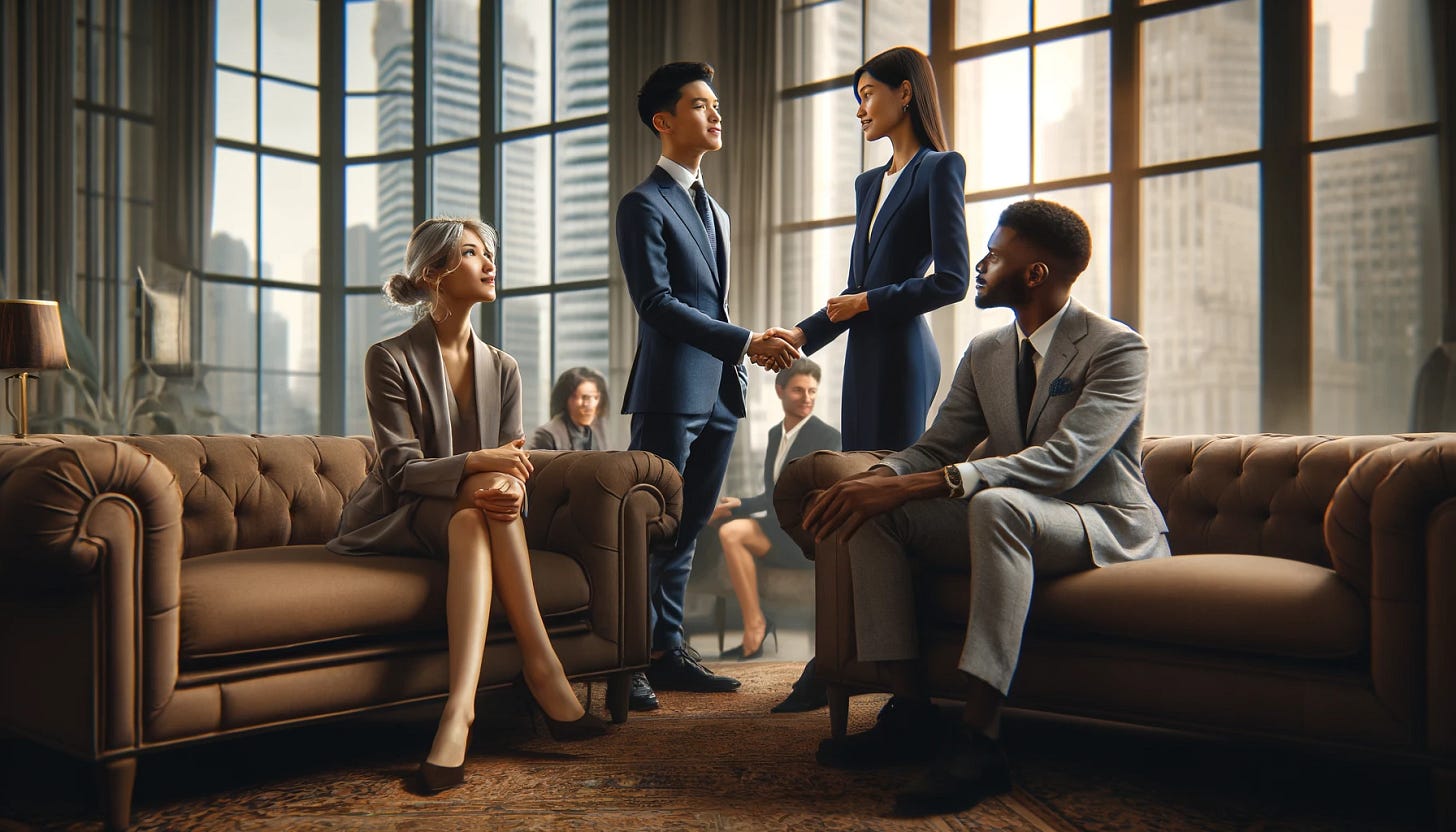Win Job Interviews with Strong First Impressions
Unlock the secrets to making a lasting first impression in job interviews with expert tips on attire, body language, and compelling elevator pitches.
You've probably heard the saying, "You never get a second chance to make a first impression." Nowhere is this truer than in a job interview. Research shows that interviewers form impressions of candidates in the first few seconds of meeting them - and these snap judgments can predict the outcome of the entire interview.
In the study titled "The Importance of First Impressions in a Job Interview", researchers found that untrained observers could predict the outcome of a job interview after watching just the first 20 seconds of the interaction, before any formal questions were asked.
The observers' initial impressions, based solely on the interviewee's clothes, smiles, and handshakes, closely matched the final evaluations given by the trained interviewers after a 20-minute session.
This phenomenon, known as "thin slice judgments," suggests that we make rapid inferences about a person's traits, abilities, and interpersonal warmth based on minimal information. These quick evaluations are often intuitive and unconscious, driven by our innate tendency to categorize and make sense of our social world.
Another factor at play is the "primacy effect," which states that information presented early in an interaction carries more weight in shaping overall perceptions. In other words, what happens in the first 30 seconds of your interview may matter more than what happens in the next 30 minutes.
But here's the good news: while you can't control every factor that influences first impressions, there are concrete steps you can take to put your best foot forward. By understanding the science behind first impressions and preparing accordingly, you can make a positive impact from the moment you walk through the door - and set yourself up for interview success.
The Science of Snap Judgments
When we meet someone new, our brains are wired to make rapid inferences about who they are and how they will behave. Research shows that these snap judgments are based on a variety of cues, from facial features to body language to vocal tone.
One of the most powerful drivers of first impressions is facial appearance. Studies have found that we can infer personality traits like trustworthiness, competence, and likeability from a person's face in as little as 100 milliseconds.1
In one experiment, researchers showed participants photos of political candidates for just one second and found that their snap judgments of competence predicted the actual election outcomes2.
But our first impressions aren't always accurate. They are often colored by stereotypes and preconceptions, even in the absence of evidence. For example, a study found that when therapists were primed with African American stereotypes, it negatively influenced their initial evaluations of a hypothetical patient, compared to a control group primed with neutral words3.
Appearance also plays a significant role in shaping first impressions. The "what is beautiful is good" stereotype suggests that physically attractive people are judged more favorably on a range of traits, from intelligence to kindness4.
In a job interview context, one study found that more attractive candidates were judged as more hirable, even when their qualifications were identical to less attractive counterparts5.
Of course, many other factors influence the first impressions we form in an interview setting, from the firmness of a handshake to the confidence in a person's voice. The key takeaway is that these snap judgments, while not always rational or accurate, can have a profound impact on interview outcomes.
By understanding the science behind first impressions, job seekers can take proactive steps to manage the cues they are sending. In the next section, we'll explore some practical strategies for making a positive first impression in those crucial initial seconds of an interview.
5 Tips to Ace Your First Impression
Now that you understand the science behind first impressions, let's dive into some practical strategies you can use to make a positive impact in those critical first 30 seconds of your interview.
1. Dress for success
Your attire is one of the first things your interviewer will notice. Research shows that clothing can influence perceptions of competence, likeability, and even hirability. In one study, interviewers rated candidates dressed in professional attire as more suitable for hire than those in non-professional dress6. Choose clothes that are appropriate for the company culture and convey a polished, put-together image.
2. Master non-verbals
Your body language speaks volumes before you even open your mouth. Smile genuinely as you enter the room, make eye contact, and offer a firm (but not crushing) handshake. Maintain good posture and open body language throughout the interview. These non-verbal cues can convey confidence, warmth, and engagement.
3. Prepare an elevator pitch
The "tell me about yourself" question is a golden opportunity to make a strong first impression. Craft a concise, compelling narrative that highlights your key strengths and experiences, tailored to the role you're interviewing for. Practice delivering your pitch with confidence and enthusiasm.
Example of an elevator pitch
"I'm a marketing professional with over 5 years of experience in digital marketing, specializing in content strategy and social media management. At my current role at ACME, I led a team to increase website traffic by 150% in one year, through innovative SEO strategies and engaging content creation. I thrive in fast-paced environments, love a challenge, and am always looking for ways to drive engagement and build strong brand presence. I'm excited about the opportunity to bring my expertise in digital marketing and my track record of success to your team, where I aim to contribute to impactful projects and further growth."
4. Exude warmth and competence
According to social psychologist Amy Cuddy7, warmth and competence are the two key dimensions that drive our social judgments. Conveying both traits in your first impression is crucial. Demonstrate warmth through friendly facial expressions, a genuine smile, and showing interest in the interviewer. Showcase competence through your professional demeanor, articulate responses, and relevant examples of your skills in action.
5. Be authentic
While it's important to manage the impression you make, don't try to be someone you're not. Authenticity is key to building trust and rapport. Let your true personality shine through in a professional manner. Focus on being the best version of yourself, not a fake persona.
Remember, first impressions aren't just about what you say - they're about how you make people feel. By combining these strategies with genuine engagement and enthusiasm, you can create a memorable positive impact in those crucial first seconds of your interview.
Making It Last: Solidifying Your Positive First Impression
You've made a great first impression in those crucial initial seconds of your interview. Congratulations! But your work isn't done yet. To truly stand out from other candidates and leave a lasting, positive impact, you need to reinforce and build upon that initial impression throughout the rest of the interview.
One key strategy is to continue demonstrating the positive traits you conveyed early on. If you initially showcased your enthusiasm and passion for the field, find opportunities to share specific examples of projects or experiences that highlight your deep engagement. If you emphasized your collaborative nature, weave in anecdotes of successful teamwork and communication throughout your responses. Consistently reinforcing the qualities that made a strong first impression helps solidify them in the interviewer's mind.
Another approach is to use storytelling to your advantage. Research shows that stories are powerful tools for shaping perceptions and leaving a memorable impact8. When discussing your qualifications and experiences, don't just list facts and figures. Share concise, compelling narratives that illustrate your strengths, values, and problem-solving skills in action. A well-crafted story that aligns with the positive impression you want to create can be far more effective than a dry recitation of your resume.
As the interview progresses, be sure to maintain the same level of energy, engagement, and professionalism that you brought to the first 30 seconds. It's not uncommon for nerves or fatigue to set in, but do your best to stay focused, attentive, and upbeat. Actively listen to the interviewer's questions, take a moment to compose your thoughts, and respond with clarity and conviction. Maintain good eye contact, open body language, and a confident yet approachable demeanor.
Finally, don't underestimate the power of a strong closing. The peak-end rule suggests that people tend to remember the high points and final moments of an experience most vividly9.
Finish your interview on a high note by reiterating your key strengths, expressing your sincere excitement about the opportunity, and thanking the interviewer for their time and consideration. You might even circle back to a memorable point from early in the conversation, creating a satisfying sense of closure.
By following these strategies, you can ensure that your positive first impression isn't just a fleeting moment, but a lasting foundation for a successful interview and a potential job offer. Remember, every interaction throughout the interview matters, but by starting strong and staying consistent, you position yourself as a top candidate who leaves a memorable, positive impact.
From Hello to Hired: First Impressions as the Foundation of Interview Success
We've explored the science and strategies behind making a great first impression in a job interview. But why do these initial moments matter so much in the hiring process?
The truth is that first impressions serve as the foundation for everything that follows in an interview. Those snap judgments formed in mere seconds can color how the interviewer perceives and interprets all subsequent information about you.
A positive first impression can create a halo effect, predisposing the interviewer to view you in a favorable light. Conversely, a negative first impression can lead to an uphill battle, requiring you to work twice as hard to overcome initial doubts or reservations.
However, the impact of first impressions goes beyond the interview itself. In many cases, the interview is the first real human interaction a candidate has with a potential employer. It sets the tone for how they view you as a prospective colleague, team member, and representative of their organization. A strong, positive first impression can lay the groundwork for a successful working relationship, even before an offer is extended.
So, what can you do to ensure your first impression sets you up for interview success? The key is a combination of awareness and preparation. By understanding the factors that influence initial perceptions, from your attire to your body language to your opening responses, you can proactively manage the cues you're sending.
This doesn't mean being inauthentic or rehearsed but rather being intentional about presenting your best self from the moment you walk in the door.
Ultimately, the power of first impressions reminds us that small moments can have a big impact in the interview process. A genuine smile, a confident handshake, small talk, a well-crafted response to "tell me about yourself" - these are not just trivial niceties, but crucial opportunities to shape how you're perceived and evaluated.
By investing time and effort into honing these initial interactions, you give yourself a valuable edge in a competitive job market.
Of course, a great first impression alone won't guarantee a job offer. You still need to demonstrate your qualifications, articulate your value, and connect your skills to the needs of the role and the organization. But by starting strong and building upon that positive foundation throughout the interview, you position yourself as a compelling, memorable candidate who stands out from the rest.
So the next time you're preparing for a job interview, remember the power of hello. Those first 30 seconds may seem fleeting, but they can set the trajectory for your entire interview experience - and ultimately, your career path.
By mastering the art and science of first impressions, you take a crucial step towards turning that initial hello into an exciting new role.
Share this article or any other article to unlock exclusive premium content (guides, strategies, insights) that is behind a paywall. Discover how to do it here!
Fixing a Bad First Impression: How to Turn Things Around
Despite your best efforts, sometimes first impressions don't go as smoothly as planned. Maybe you spilled coffee on your shirt on the way to the interview, or you fumbled over your words when answering the first question.
The good news is that first impressions, while powerful, are not necessarily set in stone. With the right approach, it's possible to recover from a negative start.
This is how you can do that:





